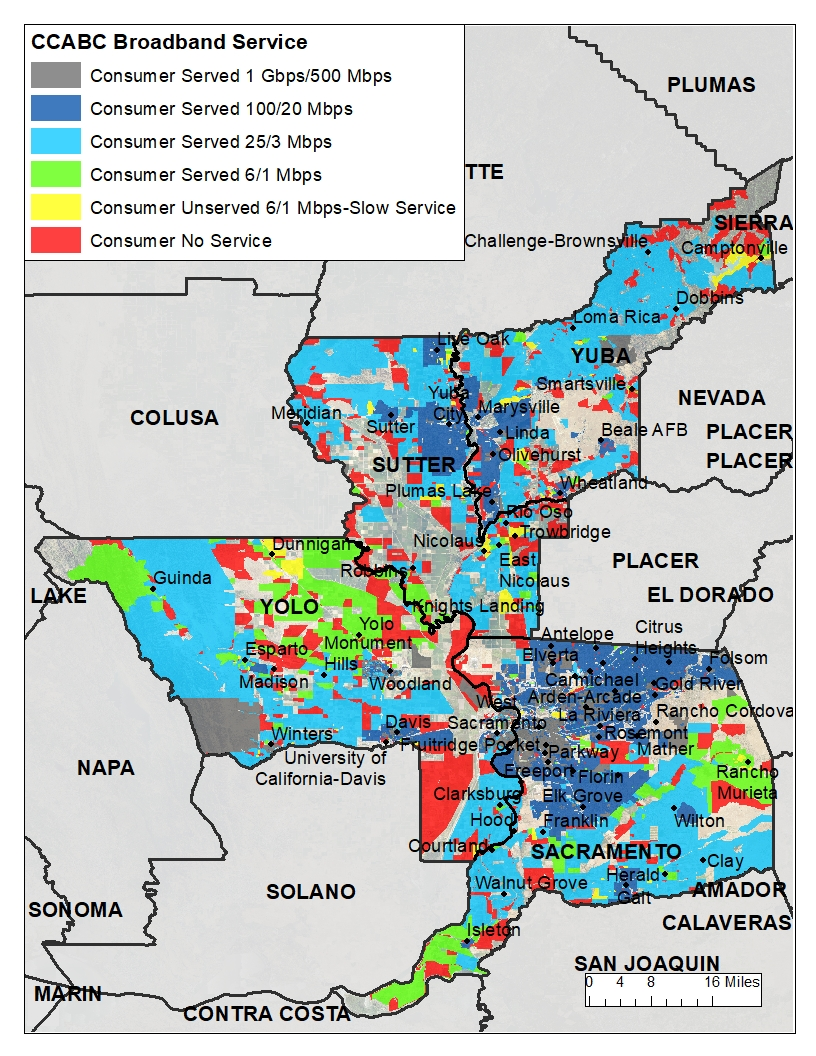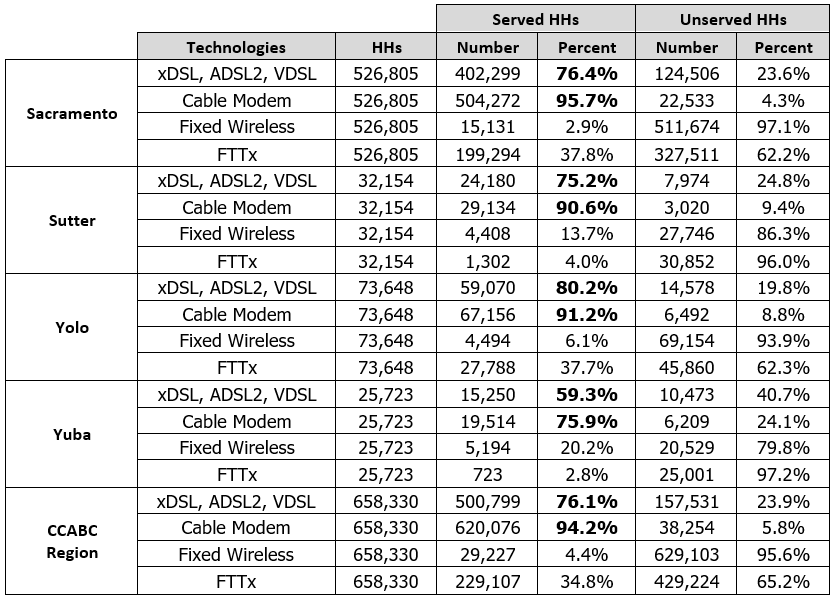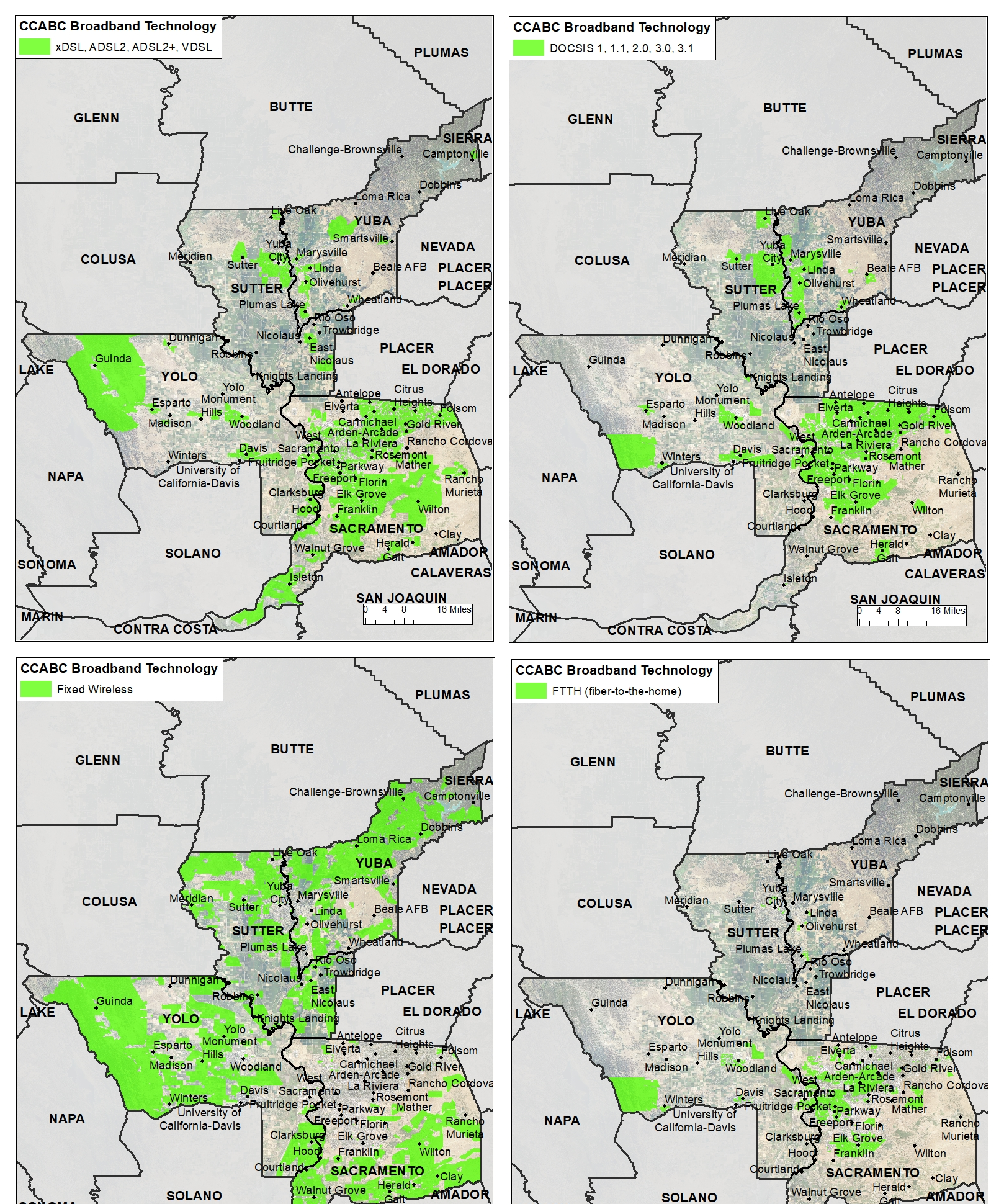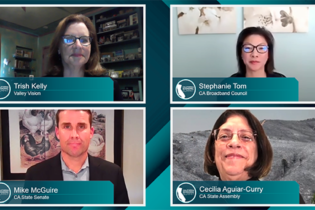The Latest on Broadband Coverage in the Capital Region

In November 2020, the California Public Utilities Commission (CPUC) released the latest broadband availability data that reflect broadband coverage in California as of December 2019. This blog will present an overview of the broadband coverage in the Connected Capital Area Broadband Consortium (CCABC) Region, and in the four counties (Sacramento, Sutter, Yolo and Yuba), based on the following speed standards:
- 6/1 Mbps (megabits per second): Current California standard (AB1665).
- 25/3 Mbps: FCC standard. Minimum recommended in a previous blog for households using video conference applications for education or work, and/or having multiple simultaneous users at home.
- 100/20 Mbps: Goal set in the Governor’s Executive Order and the California Broadband 4 All Action Plan.
- 1Gbps/500Mbps: FCC Gigabit service standard.
Based on these standards, the table below presents the coverage and percentage of served and unserved households. At the standard of 6/1 Mbps, the region is at 97.4% coverage (around 17,000 unserved households) which is close to the goal of 98% broadband access in California and in each consortium region. Sacramento has the highest coverage, 97.7%, followed by Sutter, 97%, Yolo, 96.4%, and Yuba, 94.7%. For the 25/3 Mbps standard, the figures are slightly below, achieving a 96.9% in the region (around 20,000 unserved households). At the 100/20 Mbps standard, the regional coverage turns into 93.2%, increasing the number of unserved households to around 44,000. For these three standards, regional coverage is comfortably above 90% coverage, however, for the Gigabit standard, the regional coverage dramatically drops to 22.5% or half a million unserved households.

The figure below shows the layered coverage at the speed standards mentioned above. The higher speeds coverage, 100/20 Mbps and Gigabit (in blue and gray, respectively), is mostly in main urban and densely populated areas across the region. Speeds of 6/1 Mbps and 25/3 Mbps (in light blue and green, respectively) are also available in these areas, and additionally, in suburban and some rural areas. Areas unserved at 6/1 Mbps or with no service are mostly scattered across rural areas across the four counties.

The table and figure below present the broadband coverage by four technologies widely used to provide internet service: DSL, Cable Modem, Fiber to the location (FTTx), and fixed wireless (unlicensed and licensed). Cable Modem has the highest coverage in the region, 94%, and in each of the four counties, followed by legacy DSL, 76%. FTTx achieves a regional presence of around 35%, followed by fixed wireless, 4%. It is important to note that in the figure below, fixed wireless shows the largest footprint in the region, however, this coverage is mostly in less densely populated rural areas. As a result, fixed wireless covers less number of households than the other technologies.


It is important to note that the CPUC broadband availability data is self-reported from ISPs and telecom companies. Many local broadband stakeholders (local governments, communities, residents, and other ISPs) have expressed concerns that some of the data do not reflect what is actually available. For those cases, the CPUC has implemented several validation methods which can be found here. The CCABC recommends internet users to download and run the CalSPEED app (calspeed.org) in order to validate broadband coverage and speeds in the region. In conclusion, these latest CPUC broadband availability figures show that, based on the California 6/1 Mbps standard, our consortium region is still below the 98% availability for households. For the other standards, availability continues dropping to near 93% for 100/20 Mbps, and 22% for an ideal Gigabit service.
This 2021, the Connected Capital Area Broadband Consortium (CCABC) looks forward to continuing working with all broadband stakeholders to get closer to the goal of achieving ubiquitous reliable high-speed and affordable broadband internet for all.
To continue staying up to date with all of the region’s broadband efforts, subscribe to Valley Vision’s e-Connect email newsletter!
David Espinoza is a former Valley Vision Project Leader who managed broadband projects and other initiatives in the Innovation & Infrastructure impact area.




